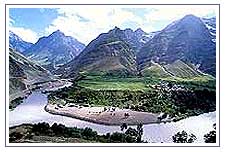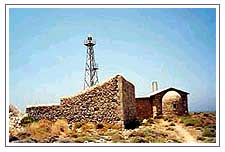|
| Adventure in Zanskar, Lahaul
& Spiti
|
|
|
The Zanskar valley is noted for its high ranges, fine Gompas and gentle
people. The most isolated of all Himalayan valleys inaccessible for 8 months
in a year, it is now a popular destination with trekkers.
Set in a wide plain where two swift flowing tributaries join to form the
Zanskar River, is Padum the main habitation and the sub divisional
headquarters. Close to the town are a set of ancient rock carvings and two
picturesque monasteries, the Stagrimo and Pibiting Gompas. A two-hour trek
from Padum takes one to Karsha with the largest and most wealthy Gompa in
the region. It dates back tot he 16th century. Other interesting monasteries
include the castle like Gompa at Sani, the splendid Stongdey perched on a
rocky outcrop, Bardan and the spectacularly located Phugthal just off the
Padum-Manali trail.
The Lahaul
plateau nourished by the Chandra and Bhaga rivers and the Spiti valley
linked to it by a high pass the Kunzam la, are together a district in
Himachal Pradesh - another region where nature can be seen at its wildest.
Lahaul is glacier country and some of its most dramatic glaciers include the
Bara Shigri, Chota Shigri, Samundari and Sonapani glaciers.
The narrow Spiti valley carved out by the swift flowing Spiti River rising
from the slopes of the Kunzam la is an area of weathered gorges and dramatic
mountain scapes. In summer the valleys are green, the meadows carpeted with
flowers and a patchwork of fields ornaments the villages. The people are
charming, friendly and hospitable.
The only
approach to this exotic region is by road. The rugged Manali-Leh highway
(N.H.21) one of the highest mountain roads in the world is open for 3 months
in the year from early June to September. It traverses the subdivision of
Lahaul and crosses the Great Himalayan range into Ladakh. Manali in Kullu
district is the ideal base for visits to this area. It is in turn linked by
road and air to Chandigarh, Shimla and Delhi.
Manali with
its forested slopes and beautiful scenery is the start of an arduous journey
across some of the most fascinating landscapes in the country. The Rohtang
pass is not far from Manali and takes one abruptly from the lush meadows of
the Kullu valley into the barer hills and rocky landscape of Lahaul. At
Gramphu the road from Spiti coming over the Kunzam pass meets the highway.
Just 18-km from Keylong, the sub divisional headquarters, an imposing 7
storeyed structure, the fort of Gondla seems to guard the road.

At
the confluence of the Chandra and Bhaga Rivers, just short of Keylong is
Tandi. From here one can visit the monastery of Guru Ghantal believed to
have been established by the guru Padmasambhava himself about 800 years ago.
Keylong, located on the Bhaga River makes a splash of emerald in the browns
and greys of the surrounding hills with its fields, trees and watercourses.
Close to Keylong is the Shashur monastery. It is perched almost 600m above
the valley and a steep and difficult track leads up to it. Khardong the
largest Gompa in the area is located across the valley from Shashur. Udaipur
in Upper Lahaul is an interesting excursion. It is also the base for treks
to the Zanskar valley.
Beyond Keylong the road follows the river Bhaga winding upwards to the
Baralacha-la, the pass across the Great Himalayan Range. The Zanskar range
and two more high passes the Lungalacha-la and the Taglang-la have to be
crossed before the road descends to the Indus plain and on to Leh. The
473-km drive is fairly arduous and the journey can be broken with stops at
sarchu the last post at the Himachal border or pang where there are tented
camps.
Spiti is
accessible during the brief summer months from Manali via the Manali - Leh
highway. The road branches off from Gramphu in Lahaul to cross the high
Kunzam la. The longer but popular route into the valley is along the old
Hindustan - Tibet road from Shimla across the scenic district of Kinnaur.
There are interesting little towns along this route. Sarahan is picturesque
and is noted for the Bhimakali temple with its impressive architecture.
Further into Kinnaur the beautiful Baspa valley and the village of Sangla
provide a breathtaking excursion. Kalpa with its fine view of the Kinner
Kailash Peak and Nako with a little lake make fascinating breaks in the
journey.
Attractions In Spiti

Spiti
which means 'Middle Country' is a vast highland basin for swift
flowing glacial streams that have cut deep gorges into the mountain terrain.
Among them pin and Lingti are the main streams that feed the Spiti River.
The Lingti valley is a living geological museum noted for its shales and
fossils, dating back 250 million years. The pin valley, a protected area
with its National Park is the habitat of the ibex and snow leopard.
Spiti valley is barely 3-km wide and most of the villages are located along
its wider bank. The terraced fields, groves of juniper and flat roofed
houses are set against the backdrop of rocky mountain - sides that seem
painted in shades of purple and pink. Some of the hills are eroded through
the reveal its undulating strata.
Isolated in the deep valleys the culture of Spiti has developed
undisturbed, in a little world that centres around its many Buddhist Gompas.
Dhankar, Ki or Kye, Tabo, Mud, Kungri, Lidang, Hikim, Sangnam are the more
prominent of the 30 or more monasteries in Spiti.
Spiti's most sacred Gompa, the 1,000-year-old Tabo monastery, is a
treasure house of art. Over the centuries succeeding generations contributed
to its expansion and embellishment and today tabo has nine temples with a
wealth of fine murals and painted stucco work that unfolds the iconography
of the region. In the temple of enlightened gods, which is the du-khang or
assembly hall of the complex, there are beautiful murals painted in an
Indian style. This is why tabo is known as the 'Ajanta of the Himalayas'.
Tabo is located not far from sumdo on the kinnaur-spiti border.
Just 25-km from Tabo is the Dhankar monastery. Dhankar was once the capital
of Spiti. The hilltop Gompa, which doubled as a jail in the old days,
dominates the village. The main attraction at dhankar is a natural lake at
13,500 ft., a perfect camping site, a walk of 2.5-km from the village.
Proceeding along the state highway towards Kaza, the sub divisional
headquarters of Spiti, one gets to Attergu. This is the point of access to
the pin valley where there is an interesting gompa at kungri. Close by too,
is the lingti valley.
Kaza is located 76-km south east of Kunzam la and 74-km from Sumdo. Ki
Gompa the largest in the valley is 11 km away, located above Kaza at the
height of 4116 m. fine murals and a valuable collection of Kangyur - ancient
Buddhist texts are its attractions. Among its other treasures are two horns
almost three metres long. Brought out on festive occasions they resound
across the valley.
Air:
Lahaul - Nearest airport is at Kullu in the Kullu valley.
Road:
Keylong - Accessible by road from Manali on the Manali-Leh highway. Bus
services link Keylong to Manali and to the Spiti valley. Daily deluxe bus
services run by HPTDC (Himachal Pradesh Tourism Development Corporation) ply
daily on the Manali-Leh route with an overnight halt at the tented camp at
Sarchu.
High Altitude Travel


 At
the confluence of the Chandra and Bhaga Rivers, just short of Keylong is
Tandi. From here one can visit the monastery of Guru Ghantal believed to
have been established by the guru Padmasambhava himself about 800 years ago.
Keylong, located on the Bhaga River makes a splash of emerald in the browns
and greys of the surrounding hills with its fields, trees and watercourses.
At
the confluence of the Chandra and Bhaga Rivers, just short of Keylong is
Tandi. From here one can visit the monastery of Guru Ghantal believed to
have been established by the guru Padmasambhava himself about 800 years ago.
Keylong, located on the Bhaga River makes a splash of emerald in the browns
and greys of the surrounding hills with its fields, trees and watercourses.  Spiti
which means 'Middle Country' is a vast highland basin for swift
flowing glacial streams that have cut deep gorges into the mountain terrain.
Among them pin and Lingti are the main streams that feed the Spiti River.
The Lingti valley is a living geological museum noted for its shales and
fossils, dating back 250 million years. The pin valley, a protected area
with its National Park is the habitat of the ibex and snow leopard.
Spiti
which means 'Middle Country' is a vast highland basin for swift
flowing glacial streams that have cut deep gorges into the mountain terrain.
Among them pin and Lingti are the main streams that feed the Spiti River.
The Lingti valley is a living geological museum noted for its shales and
fossils, dating back 250 million years. The pin valley, a protected area
with its National Park is the habitat of the ibex and snow leopard.